Text-to-SQL: A Developer’s Zero-to-Hero Guide
TL;DR Build your own text-to-SQL system that translates natural language into database queries. This guide covers implementation approaches from rule-based to ML models, practical code examples, and production-ready best practices for security and performance. What You'll Learn How to translate natural language queries into SQL with NLP Building both rule-based and ML-based text-to-SQL systems Implementing error handling, security, and performance optimizations Advanced features like multi-turn conversations and visualization Troubleshooting common challenges in real-world deployments The Developer's Text-to-SQL-Challenge As developers, we've all been there: PM: "Can you pull last quarter's revenue by product category?" You: "Give me an hour to write the SQL..." What if anyone in your organization could get answers directly from your database without knowing SQL? That's the promise of text-to-SQL systems. This guide will show you how to build a production-ready text-to-SQL pipeline that empowers non-technical users while maintaining security and performance. We'll focus on practical implementation rather than theory. The Building Blocks of Text-to-SQL System: SQL and NLP Before going into the details of building a text-to-SQL system, let's understand the two core pillars that enable the translation of human-readable questions into database queries: SQL (Structured Query Language) Natural Language Processing (NLP) These technologies work together to translate human-readable questions into database queries. Let’s break them down. Understanding SQL SQL is the language of relational databases. It helps us to interact with structured data, retrieve information, and perform complex operations like filtering, sorting, and aggregating. Here’s a quick look at the basics: SELECT: specifies the columns you want to retrieve FROM: specifies the table containing the data WHERE: filters rows based on conditions GROUP BY: aggregates data based on one or more columns ORDER BY: sorts result in ascending or descending order JOIN: combines data from multiple tables based on related columns For instance, we can create a query that calculates the total revenue by city for 2024, sorted in descending order. SELECT city, SUM(revenue) FROM sales WHERE year = 2024 GROUP BY city ORDER BY SUM(revenue) DESC; Schema design A database schema defines the structure of your data, including tables, columns, and relationships. For example, a sales table might have columns like invoice_id, date, product, and revenue. A well-designed schema allows text-to-SQL systems to generate accurate queries. Natural language processing (NLP) NLP enables machines to understand and process human language. In the text-to-SQL context, NLP helps interpret natural language questions and map them to database structures. Here’s how it works: Tokenization: It’s about breaking down a sentence into individual words or tokens. For example: Input: "Show me sales in New York." Tokens: ["Show", "me", "sales", "in", "New", "York"] Intent recognition: Identifying the user’s goal. For instance, the question "What’s the total revenue?" intends to perform an aggregation (SUM). Entity extraction: Detecting key pieces of information, such as: Dates: "last quarter" → WHERE date BETWEEN '2023-07-01' AND '2023-09-30'. Locations:"New York" → WHERE city = 'New York'. Schema linking: Mapping natural language terms to database schema elements. For example: "sales" → sales table. "revenue" → revenue column. For instance, if a user asks, “What are the top five products by sales in Q1 2023?”, an NLP model would: Identify key entities like “products,” “sales,” and “Q1 2023.” Map these to corresponding database tables and columns. Generate an SQL query. SELECT product_name, SUM(sales_amount) AS total_sales FROM sales WHERE quarter = 'Q1' AND year = 2023 GROUP BY product_name ORDER BY total_sales DESC LIMIT 5; Text-to-SQL Implementation Approaches Different implementation approaches can be employed for building a text-to-SQL pipeline, depending on the queries' complexity, the database's size, and the level of accuracy required. Below, we’ll discuss two primary approaches, including: Rule-based systems Machine learning-based systems Rule-based systems Rule-based systems depend on manually crafted rules and heuristics to convert natural language queries into SQL commands. These systems are deterministic, which means they adhere to a fixed set of instructions to generate queries. Rule-based systems work by parsing natural language inputs into structured representations and then applying a set of predefined templates or grammatical rules to generate SQL queries. For example, the rule for the query, “Show me sales in New York last quarter," can look like this: IF "sales" AND "in [location]" AND "last quarter" THEN: SELECT * FROM sales WHERE city = [l

TL;DR
Build your own text-to-SQL system that translates natural language into database queries. This guide covers implementation approaches from rule-based to ML models, practical code examples, and production-ready best practices for security and performance.
What You'll Learn
- How to translate natural language queries into SQL with NLP
- Building both rule-based and ML-based text-to-SQL systems
- Implementing error handling, security, and performance optimizations
- Advanced features like multi-turn conversations and visualization
- Troubleshooting common challenges in real-world deployments
The Developer's Text-to-SQL-Challenge
As developers, we've all been there:
PM: "Can you pull last quarter's revenue by product category?"
You: "Give me an hour to write the SQL..."
What if anyone in your organization could get answers directly from your database without knowing SQL? That's the promise of text-to-SQL systems.
This guide will show you how to build a production-ready text-to-SQL pipeline that empowers non-technical users while maintaining security and performance. We'll focus on practical implementation rather than theory.
The Building Blocks of Text-to-SQL System: SQL and NLP
Before going into the details of building a text-to-SQL system, let's understand the two core pillars that enable the translation of human-readable questions into database queries:
- SQL (Structured Query Language)
- Natural Language Processing (NLP)
These technologies work together to translate human-readable questions into database queries. Let’s break them down.
Understanding SQL
SQL is the language of relational databases. It helps us to interact with structured data, retrieve information, and perform complex operations like filtering, sorting, and aggregating. Here’s a quick look at the basics:
SELECT: specifies the columns you want to retrieveFROM: specifies the table containing the dataWHERE: filters rows based on conditionsGROUP BY: aggregates data based on one or more columnsORDER BY: sorts result in ascending or descending orderJOIN: combines data from multiple tables based on related columns
For instance, we can create a query that calculates the total revenue by city for 2024, sorted in descending order.
SELECT city, SUM(revenue)
FROM sales
WHERE year = 2024
GROUP BY city
ORDER BY SUM(revenue) DESC;
Schema design
A database schema defines the structure of your data, including tables, columns, and relationships. For example, a sales table might have columns like invoice_id, date, product, and revenue. A well-designed schema allows text-to-SQL systems to generate accurate queries.
Natural language processing (NLP)
NLP enables machines to understand and process human language. In the text-to-SQL context, NLP helps interpret natural language questions and map them to database structures. Here’s how it works:
Tokenization: It’s about breaking down a sentence into individual words or tokens. For example:
Input: "Show me sales in New York."
Tokens: ["Show", "me", "sales", "in", "New", "York"]
Intent recognition: Identifying the user’s goal. For instance, the question "What’s the total revenue?" intends to perform an aggregation (SUM).
Entity extraction: Detecting key pieces of information, such as:
Dates: "last quarter" →
WHERE date BETWEEN '2023-07-01' AND '2023-09-30'.Locations:
"New York" → WHERE city = 'New York'.Schema linking: Mapping natural language terms to database schema elements. For example:
"sales" →
salestable."revenue" →
revenuecolumn.
For instance, if a user asks, “What are the top five products by sales in Q1 2023?”, an NLP model would:
Identify key entities like “products,” “sales,” and “Q1 2023.”
Map these to corresponding database tables and columns.
Generate an SQL query.
SELECT product_name, SUM(sales_amount) AS total_sales
FROM sales
WHERE quarter = 'Q1' AND year = 2023
GROUP BY product_name
ORDER BY total_sales DESC
LIMIT 5;
Text-to-SQL Implementation Approaches
Different implementation approaches can be employed for building a text-to-SQL pipeline, depending on the queries' complexity, the database's size, and the level of accuracy required. Below, we’ll discuss two primary approaches, including:
Rule-based systems
Machine learning-based systems
Rule-based systems
Rule-based systems depend on manually crafted rules and heuristics to convert natural language queries into SQL commands. These systems are deterministic, which means they adhere to a fixed set of instructions to generate queries.
Rule-based systems work by parsing natural language inputs into structured representations and then applying a set of predefined templates or grammatical rules to generate SQL queries. For example, the rule for the query, “Show me sales in New York last quarter," can look like this:
IF "sales" AND "in [location]" AND "last quarter"
THEN:
SELECT * FROM sales
WHERE city = [location]
AND date BETWEEN [start_of_quarter] AND [end_of_quarter];
And the generated SQL query will look like this:
SELECT * FROM sales
WHERE city = 'New York'
AND date BETWEEN '2023-07-01' AND '2023-09-30';
But, as databases grew in size and complexity, rule-based systems became impractical, paving the way for machine learning-based approaches.
Machine learning-based systems
Machine learning (ML) approaches to text-to-SQL use algorithms to learn how to map between natural language inputs and SQL queries. These systems can handle more complex and varied queries compared to rule-based methods.
Machine learning models depend on feature engineering to extract relevant input text and database schema information. Features such as part-of-speech tags, named entities, and schema metadata (e.g., table names and column types) are extracted from the input. A classifier or regression model then predicts the corresponding SQL query based on these features.
LSTM-based models
Long short-term memory (LSTM) networks were among the first deep-learning approaches applied to text-to-SQL tasks. They can effectively model the sequential nature of natural language and SQL queries.
For instance, Sequence-to-Sequence (Seq2Seq) architectures commonly used with LSTMs treat the problem as a translation task, converting natural language sequences into SQL sequences. They consist of two elements:
An encoder processes the input natural language query and generates a context vector that understands the query's meaning.
A decoder uses the context vector to generate the SQL query step-by-step.
Transformer-based models
Transformer-based models, like BERT, GPT, and Llama, have become the dominant approach in text-to-SQL. These models use a self-attention mechanism, allowing them to understand contextual relationships in the input text and the database schema much more effectively. Self-attention enables the model to understand, for example, that "top five products" implies sorting and limiting results.
Moreover, transformers can better handle schema information by incorporating it into the model's input or using specialized schema encoding techniques.
Best Text-to-SQL Practices and Considerations
Building a text-to-SQL system is more than just wiring together NLP models and databases. You need to adopt industry-tested practices and anticipate common pitfalls to ensure reliability, scalability, and security. There are actionable strategies to optimize your system—which we’ll discuss next—including schema design, error handling, and navigating real-world challenges.
Data preparation and schema design
The quality of your database schema directly impacts the performance and accuracy of your text-to-SQL system. Ensure that your database is well-structured, with normalized tables to minimize redundancy. Use intuitive and descriptive column names that align with natural language terms. Provide metadata about tables, columns, and relationships (e.g., unit_price → "USD, before tax") to help the system map natural language inputs to the correct schema elements.
-- Good Schema
CREATE TABLE sales (
order_id INT PRIMARY KEY,
order_date DATE,
customer_id INT,
total DECIMAL(10,2) -- Total amount in USD
);
-- Poor Schema
CREATE TABLE tbl1 (
col1 INT,
col2 DATE,
col3 INT,
col4 DECIMAL(10,2)
);
Handling ambiguity and user intent
Natural language is inherently ambiguous, and users may phrase queries in unexpected ways. Addressing their ambiguity is crucial for generating accurate SQL queries. One study found that nearly 20 % of the user questions are problematic, including 55 % ambiguous and 45 % unanswerable.
There are multiple ways to handle the ambiguities, including:
Clarification prompts: If the input is unclear, prompt the user for clarification. This approach improves user experience and reduces errors.
Synonym mapping: Map synonyms and variations to standardized terms in the database schema. For example, recognize “earnings,” “revenue,” and “income” as referring to the
sales_amountcolumn.Context awareness: Maintain context across multi-turn conversations to handle follow-up questions effectively.
Error handling
Plan for failures to maintain user trust because even the most advanced systems will occasionally generate incorrect queries. Implementing an error-handling strategy ensures a smooth user experience. Error handling strategies can include:
Graceful error messages: These provide clear and actionable feedback when a query fails or produces no results.
Fallback strategies: If the primary model fails, refer to simpler methods (e.g., rule-based templates) or ask the user to rephrase their query.
Logging and monitoring: Log failed queries and analyze them to identify patterns or recurring issues. Use this data to improve the system iteratively.
Example:
try:
sql = generate_sql(query)
except AmbiguityError as e:
return {"error": "Please clarify your question.", "options": e.options}
except UnsafeQueryError:
return {"error": "This query is not permitted."}
Security and privacy concerns
Text-to-SQL systems interact directly with databases, prioritizing security to protect your database from malicious or accidental harm.
Access control: Restrict access to sensitive tables or columns based on user roles.
Input validation: Sanitize user inputs to prevent SQL injection attacks.
Data masking: Mask sensitive information in query results (e.g., partial credit card numbers or anonymized customer IDs).
Audit trails: Maintain logs of all queries executed through the system to track usage and detect unauthorized activity.
Performance optimization
Efficient query generation and execution are essential for delivering timely results, especially for large-scale databases.
Indexing: Ensure that frequently queried columns are indexed to speed up search operations.
Caching: Cache frequently requested queries and their results to reduce database load.
Query simplification: Optimize generated SQL queries by removing unnecessary joins or filters.
Parallel processing: Leverage parallelism for complex queries involving multiple tables or aggregations.
Advanced Features in Text-to-SQL Systems
Enhancing a text-to-SQL system with advanced capabilities, including features that boost usability, scalability, and user satisfaction, is essential. Below are key advanced features of the system.
Contextual understanding and multi-turn conversations
One significant improvement in modern text-to-SQL systems is their ability to maintain context across multiple interactions, enabling multi-turn conversations. This feature is handy when users refine their queries based on previous results or ask follow-up questions.
For instance, if a user asks about sales from the last quarter and then follows up with a request to break it down by product line, the system understands that the second query refers to the same time period. The system reduces repetition and frustration by maintaining session-based memory and tracking entities like dates or regions mentioned earlier, enabling users to build on previous queries without starting over.
Integration with other systems and platforms
Text-to-SQL systems can be extended beyond standalone applications by integrating with other tools and platforms, creating end-to-end analytics workflows. Real-world use cases often require combining data from multiple sources or pushing results to external systems for further analysis or visualization.
For example, connecting the system to business intelligence (BI) tools like Tableau or Power BI allows users to generate interactive dashboards and reports directly from their natural language queries. Similarly, integrating with CRM (customer relationship management) or ERP (enterprise resource planning) systems enables users to query operational data seamlessly, such as asking how many deals were closed last month. The system can also pull data from external APIs or cloud storage services, combining internal datasets with external market trends to provide a unified view of information.
Generating visualizations from SQL output
Transforming raw query results into visual formats is another powerful feature that enhances usability and makes data more accessible to non-technical users. Visualizations help users quickly identify trends, patterns, and outliers in the data, reducing the cognitive load associated with interpreting raw tables.
Additionally, providing options to export visualizations as PDFs, PNGs, or interactive HTML files makes it easier for users to share insights with stakeholders. By presenting data in a digestible format, the system ensures that insights are not only actionable but also easily shareable.
Common Challenges in Text-to-SQL Systems
While text-to-SQL systems offer immense benefits for democratizing data access, they are not without their challenges. Here are common challenges developers and users face with these systems:
Ambiguity in natural language queries: Natural language inputs can be vague or open to multiple interpretations, leading to incorrect SQL queries.
Handling complex queries: Text-to-SQL systems may fail to generate correct SQL for complex queries that involve joins, subqueries, or nested logic.
Poor schema: Poor schemas in text-to-SQL systems can lead to incorrect column or table mappings, resulting in irrelevant query results.
Performance and scalability: Text-to-SQL systems that query large datasets or generate complex SQL can strain computational resources and slow performance.
Error recovery: Even the most advanced systems occasionally generate incorrect queries. Implementing robust error recovery strategies is essential to maintaining user trust and improving the system iteratively.
Conclusion
Text-to-SQL connects human language with database queries, enabling users to effortlessly access and analyze data without the need to write code. It uses NLP to understand user intent by translating natural language questions into SQL and mapping it to the database schema.
The main advantages of using text-to-SQL include enhanced data accessibility for non-technical users and quicker data analysis. For time-series data, leveraging a powerful time-series database like Timescale Cloud can greatly improve the performance and scalability of your text-to-SQL system.
To experience the power of time-series data with text-to-SQL, try Timescale today.































































































































































![[The AI Show Episode 143]: ChatGPT Revenue Surge, New AGI Timelines, Amazon’s AI Agent, Claude for Education, Model Context Protocol & LLMs Pass the Turing Test](https://www.marketingaiinstitute.com/hubfs/ep%20143%20cover.png)



























































































































![[DEALS] Koofr Cloud Storage: Lifetime Subscription (1TB) (80% off) & Other Deals Up To 98% Off – Offers End Soon!](https://www.javacodegeeks.com/wp-content/uploads/2012/12/jcg-logo.jpg)
























![Is this too much for a modular monolith system? [closed]](https://i.sstatic.net/pYL1nsfg.png)



























































































-The-Elder-Scrolls-IV-Oblivion-Remastered---Official-Reveal-00-18-14.png?width=1920&height=1920&fit=bounds&quality=70&format=jpg&auto=webp#)























_roibu_Alamy.jpg?width=1280&auto=webp&quality=80&disable=upscale#)




 CISO’s Core Focus.webp?#)











































































































![Apple Smart Glasses Not Close to Being Ready as Meta Targets 2025 [Gurman]](https://www.iclarified.com/images/news/97139/97139/97139-640.jpg)
![iPadOS 19 May Introduce Menu Bar, iOS 19 to Support External Displays [Rumor]](https://www.iclarified.com/images/news/97137/97137/97137-640.jpg)

![Apple Drops New Immersive Adventure Episode for Vision Pro: 'Hill Climb' [Video]](https://www.iclarified.com/images/news/97133/97133/97133-640.jpg)

































































































